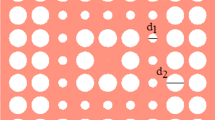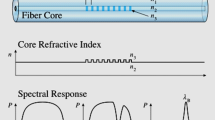Abstract
We propose an optical fiber which has very low dispersion loss (typically ~ 6.7 ps2/km at 1,550 nm) that can be achieved by doping Ag nanoparticle into the core glass. At low absorption loss approximation, dispersion free propagation can be achieved up to 64 km for a 20 ps pulse. Enhanced third order nonlinearity due to the presence of Ag nanoparticle (typically ~ 3.82 × 10−20 W/m2) compensates for long length dispersion broadening that is not possible in conventional fused silica step index fiber.







Similar content being viewed by others
References
A. Ghatak, K. Thyagrajan, Introduction to fiber optics (Cambridge University Press, Cambridge, 2004)
M.N. Hossain, M. Shah Alam, DMdN Hasan, K.M. Mohsin, A highly nonlinear spiral photonic crystal fiber for tailoring two zero dispersion wavelengths in the visible region. Photonics Lett Pol 2(3), 143–145 (2010)
J. Limpert, T. Schreiber, T. Clausnitzer, K. Zöllner, H.-J. Fuchs, E.-B. Kley, H. Zellmer, A. Tünnermann, High-power femtosecond Yb-doped fiber amplifier. Opt. Express 10(14), 628–638 (2002)
B. Ortaç, O. Schmidt, T. Schreiber, J. Limpert, A. Tünnermann, A. Hideur, High-energy femtosecond Yb-doped dispersion compensation free fiber laser. Opt. Express 15(17), 10725–10732 (2007)
T. Kurita, H. Yoshida, H. Furuse, T. Kawashima, N. Miyanaga, Dispersion compensation in an Yb-doped fiber oscillator for generating transform-limited, wing-free pulses. Opt. Express 19(25), 25199–25205 (2011)
B. Ortaç, J. Limpert, A. Tünnermann, High-energy femtosecond Yb-doped fiber laser operating in the anomalous dispersion regime. Opt. Lett. 32(15), 2149–2151 (2007)
A. Chong, J. Buckley, W. Renninger, F. Wise, All-normal-dispersion femtosecond fiber laser. Opt. Express 14(21), 10095–10100 (2006)
P.K. Jain, K.S. Lee, I.H. El-Sayed, Mostafa A. El-Sayed, Calculated absorption and scattering properties of gold nanoparticles of different size, calculated shape, and composition: applications in biological imaging and biomedicine. J. Phys. Chem. B 110(14), 7238–7248 (2006)
A.S. Medvedev, V.S. Lebedev, Modeling of light absorption and scattering by metal nanoparticles coated with organic dye J-aggregate. Kratkie Soobshcheniya po Fizike 37(6), 23–27 (2010)
W.M. Merrill, R.E. Diaz, M.M. LoRe, M.C. Squires, N.G. Alexopoulos, Effective medium theories for artificial materials composed of multiple sizes of spherical inclusions in a host continuum. IEEE Transactions on Antennas and Propagation 47(1), 142–148 (1999)
A.D. Rakić, A.B. Djurišić, J.M. Elazar, M.L. Majewski, Optical properties of metallic films for vertical-cavity optoelectronic devices. App. Opt. 37(22), 5271–5283 (1998)
R. Driben, A. Husakou, J. Herrmann, Low-threshold supercontinuum generation in glasses doped with silver nanoparticles. Opt. Express 17(20), 17989–17995 (2009)
N. Zhavoronkov, R. Driben, B.A. Bregadiolli, M. Nalin, B.A. Malomed, Observation of asymmetric spectrum broadening induced by silver nanoparticles in a heavy-metal oxide glass. Europhys. Lett. 94(3), 37011–37015 (2011)
R.W. Boyd, R.J. Gehr, G.L. Fischer, J.E. Sipez, Nonlinear optical properties of nanocomposite materials. Pure Appl. Opt. 5, 505–512 (1996)
M. Amemiya, Pulse broadening due to higher order dispersion and its transmission limit. J Lightwave Technol. 20(4), 591–597 (2002)
G.P. Agrawal, Non-linear Fiber Optics (Academic Press, San Diego, 2001)
L.F. Mollenauer, R.H. Stolen, J.P. Gordon, Experimental observation of picosecond pulse narrowing and solitons in optical fibers. Phy. Rev. Lett. 45(13), 1095–1098 (1980)
J.M. Dudley, L.P Barry, P.G. Bollond, J.D. Harvey, R. Leonhardt, Simultaneous measurement of the dispersion and nonlinearity of standard fiber using frequency resolved optical gating. ECOC 97, Conference Publication No. 448 (1997)
C.G. Granqvist, O. Hundcri, Optical properties of Ag-Si02 Cermet films: a comparison of effective-medium theories. Phy. Rev. B 18(6), 15 (1978)
D. Stroud, F.P. Pan, Self-consistent approach to electromagnetic wave propagation in composite medium: application to model granular metals. Phys. Rev. B 17, 1602–1610 (1978)
J. Sancho-Parramon et al., Modeling of optical properties of silver-doped nanocomposite glasses modified by electric-field-assisted dissolution of nanoparticles. App. Opt. 45(35), 8874–8881 (2006)
Acknowledgments
Authors thank Director, CSIR-CGCRI for permitting us to publish this work. One of the authors (R.C.) is indebted to CSIR for providing Senior Research Fellowship.
Author information
Authors and Affiliations
Corresponding author
Appendix
Appendix
All the three models have certain merits and demerits. When the doped metal particle concentration is low all three theories give similar result [10]. But when the concentration increases the Maxwell–Garnett (MG) theory becomes inaccurate as the metal particles could form a connected network in the host matrix which is not considered in the formulation. However Sheng’s model is valid when both the host and dopant are granular in nature, which does not satisfy since we consider metal particle that are doped uniformly in host matrix of silica, which is not granular in nature [19]. In such case Bruggemann’s (BG) effective medium theory is useful to calculate the permittivity of the composite structure. We have taken spherical metal particles doped in silica as dielectric medium. It can be shown that if a particle of permittivity of ε 1 is embedded in a homogeneous medium of permittivity ε 2 then effective permittivity ε eff of such a composite becomes [20]
where f is the nanoparticle filling factor given as f = V Ag/V total. For small filling factor f ≪ 1, ε eff ≈ ε 2 and ε eff + 2ε 2 ≈ 3ε eff. Under this approximation, the above equation is identical to Maxwell–Garnett equation [12]
Since the doping of Ag nano-particle in glass host is considered to be very low (around 1–2 % volume concentration) in the present case Maxwell–Garnett theory is adopted. From Eq. (9) we get
where
Equation (10.a) a, b can be used to find out the effective permittivity of the composite material. Hence the refractive index of the material can be found out from the relation n = √ε eff. In this study ε 1 denotes the permittivity of the silver nano-particle and ε 2 denotes the permittivity of the fused silica. Jordi Sancho-Parramon et al. [21] used the MG formulation to describe the experimental reflectance data of a silver-glass composite film.
Rights and permissions
About this article
Cite this article
Chattopadhyay, R., Bhadra, S.K. Dispersion tailoring in single mode optical fiber by doping silver nanoparticle. Appl. Phys. B 111, 399–406 (2013). https://doi.org/10.1007/s00340-013-5347-z
Received:
Accepted:
Published:
Issue Date:
DOI: https://doi.org/10.1007/s00340-013-5347-z




